As an Amazon Associate I earn from qualifying purchases.
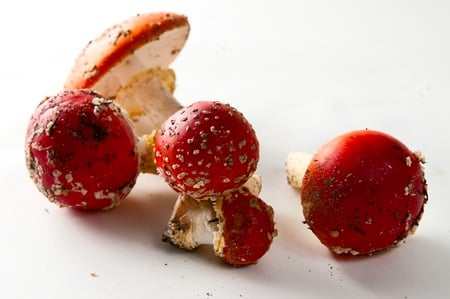
Editor’s Note: I have said this a lot in the comments before, in person and in the body of this post. Let me say it one more time, right up here in the beginning: Unless you are an expert mushroom hunter and you can 100 percent identify this mushroom, DON’T EAT IT. I wrote this post for other experts, not for just anyone to think they’ve found A. muscaria. This is serious stuff, folks. Mistake this mushroom for another amanita and you can die. Seriously. ~Hank
No mushroom presents more of an enigma than the fly agaric, Amanita muscaria. It is the most recognizable mushroom on the planet, and is widely known as the hallucinatory ‘shroom responsible for Alice’s trip into Wonderland and quite possibly our beloved images of a red-suited Santa Claus and his flying reindeer.
I am not into hallucinations. Or stomach cramping, for that matter. So for years I let this beautiful mushroom pass on my mushroom hunts. Until last weekend. We were ostensibly hunting for porcini, Boletus edulis, but as any king bolete hunter knows, the fly agaric is literally a red flag indicating that a porcino might be nestled nearby: They flush around the same time, in around the same place. And where we were on California’s Central Coast there were thousands of muscaria, a red tide in the woods.

As we walked, picking porcini and other wonderful boletes, I began having a nagging conversation with myself: You know you can eat those amanitas, right? Yes, but don’t they need all sorts of crazy processing first? Probably. But you will never get a better chance to experiment than with this flush right here, right now. OK, OK. I grabbed a separate bag and began picking.
I filled a grocery bag in no time. In fact, I could have filled the back of my pickup with muscaria. But I also had a huge haul of porcini, the prize of the day. So I dealt with them first. My dehydrator ran morning and night for days. I made porcini powder, dried quarts of porcini, made porcini risotto, and even gave some fresh ones as Christmas presents. All the while my sack of amanitas lay neglected in the garage.
I came up for air a few days ago and decided to do some research. I have a lot of mushroom books. Most say that Amanita muscaria is toxic and hallucinatory. A few call it deadly poisonous, which seems to be a stretch considering there are fewer than a handful of confirmed deaths by this mushroom and all have extenuating circumstances. (A side note: fly agaric appears to be attractive to dogs and cats and can kill them if they eat it, so keep it away from your pets!)
There is also, apparently, an entire modern subculture dedicated to tripping on this mushroom, and its use in visions dates back thousands of years — especially among those who live in the boreal forests of the north.
This is where Santa comes in. My colleague Greg Marley, whose excellent book Chanterelle Dreams, Amanita Nightmares: The Love, Lore, and Mystique of Mushrooms goes into this at length, says that fly agaric has been a symbol of yuletide happiness in Central Europe, Russia and Scandinavia for centuries, calling it “a red light shining bright in the winter darkness.” And the people of the North, as any mushroom hunter knows, are mad about mushrooms.
There is a common exchange between us Anglo ‘shroomers when we see various, “lesser” species of ‘shroom: Is it edible? Well, the Russians eat it… Amanita muscaria falls into this category.
Historically, the Siberians boiled fly agaric and then drank the pot liquor to get roaring drunk. They then preserved the mushrooms for eating later. As it happens, the Siberians’ livestock also loves this ‘shroom. And I’m not talking about cattle, I’m talking about reindeer.
Yep. Caribou will seek out Amanita muscaria just for the high — or at least it looks that way to us humans. So it’s not too far a stretch to conjure up an image of a jolly, roaringly drunk, fat, bearded dude all dressed up for the North Pole — in a red suit with white trim — chillin’ with flying reindeer.
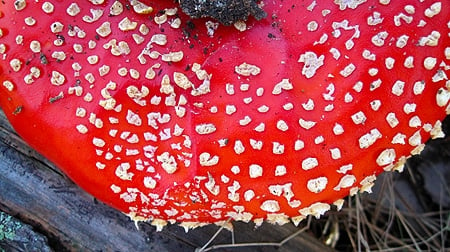
But like I said, I am not into that sort of thing. So I looked deeper. It seems that the primary toxins, er, “active ingredients,” in Amanita muscaria are ibotenic acid and muscimol. Unlike the amatoxins in the deadly amanitas — the death cap and the destroying angel — ibotenic acid and muscimol are water soluble.
More research turned up William Rubel, who knows his stuff when it comes to mushrooms. Rubel wrote an article about how to detoxify fly agaric that proved enlightening.
What’s more, he and David Arora, who is even more reknowned in the mycological world, teamed up on a longer piece (which is linked to at the bottom of Rubel’s article) about cultural attitudes toward Amanita muscaria that provides all the detail you could need on why this mushroom has such a varied place in our minds: Food. Poison. Hallucinogen.
As food, fly agaric does need special handling. Apparently most people eat only the caps or the very young buttons. They must be boiled in a large volume of water for a period of time, and then you need to toss out that water. After that, most cultures will either fry them like normal mushrooms, or pickle them, or preserve them in oil; I happen to know that a certain set of Italians do this. The Japanese around Nagano eat Amanita muscaria as pickles, as do the Lithuanians, Finns and Russians.
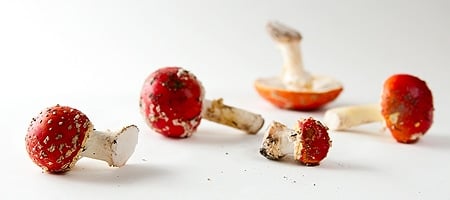
My friend Langdon Cook wrote about eating fly agaric with none other than David Arora, and he pronounced them delicious. Lang also pointed me to a cautionary article written by two mycologists who, apparently, failed to detoxify their muscaria enough. The moral of that article is to use lots of water and boil the hell out of the shrooms.
Back to my grocery bag. By the time I’d screwed up enough courage to mess around with these things, about half had gone by. Bummer. But I still had about 10 good caps to experiment with. What follows is what I did to detoxify the mushrooms. If you choose to play around with Amanita muscaria, do so at your own risk.
- I first removed all the caps and cleaned them with a brush and the side of a knife. Then I cut the caps into 1/4 inch slices.
- I filled my 12-quart stockpot up to the top, leaving about 3 inches of room to spare. I added enough salt to make the water taste salty and 1 cup of cider vinegar. Several sources say that adding salt and vinegar helps extract the toxins.
- I brought this to a boil and added the mushroom caps, then let it roll for 15 minutes.
- I then drained the mushrooms and filled the stockpot half full with fresh water and brought that to a boil. In went the mushrooms for another 5 minutes. Why? If they had gotten too vinegary or salty, this would help. Also, better safe than sorry.
The key to boiling seems to be time and water volume. You need enough water to leach out all the toxins of the mushroom, so it follows that the more muscaria you boil, the more water you’ll need. As for time, it seems 15 minutes is a pretty good interval, according to my sources.
When the slices were done with this treatment, almost all the color was gone from the previously pretty red caps. Oh well. They were still a vague ivory-yellow, but the mushrooms themselves were pale and slippery. Not appetizing. Lang and Arora ate them fried in butter, so I did the same.
I experimented with about 1 cap’s worth of slices. It is always wise to start small with any new mushroom, and especially one that has potentially toxic effects. I put the slices into a non-stick pan and let them dry saute for a few minutes. They did not exude too much water, oddly, so I added some butter and a little salt. I was happy to see the slices fry up crispy. Now we’re talking!
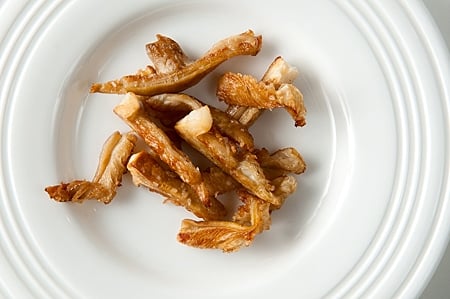
I put them on a little plate, and tentatively took a bite. I’d be lying if I told you I was not at least a little nervous. I tasted butter and salt at first, always nice, but then I got a little crisp, then the squinchy crunchiness of the mushroom, then that nutty flavor everyone who’s eaten muscaria talks about. Reflexively, I reached for another slice, then another and another.
I had to force myself to stop at 1 cap’s worth. They were that good. Now it was time to wait.
The mycologists who’d boiled their muscaria in too little water for too short a time started tripping at 20 minutes. So I sat down to watch Boise State beat the crap out of Arizona State and waited. I was wondering if Boise’s crazy blue uniforms would spark some weird hallucination. But no. I looked at my watch: 45 minutes and nothing. The game got boring. Holly and I then watched a show about a bunch of Vikings getting beheaded in England 1000 years ago, which, in retrospect, was probably not ideal if I were about to go on a mushroom trip. But no. I looked at my watch again: Two hours had passed and nothing.
If a trip were coming, it would have hit by then. What’s more, I had neither stomach cramps nor any other ill effects whatsoever. Success!
Now you may be asking yourself why I would bother messing around with Amanita muscaria when I had just hauled in pounds of boletes? First off, fly agaric is one of the easiest mushrooms in the world to identify. Even though it has some color variation, like the yellow-orange one below, if you stick to the red and orange color phases Amanita muscaria is unmistakable.
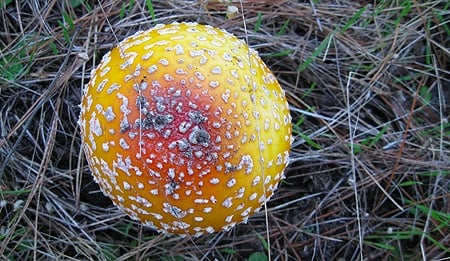
Now white and light-yellow phase muscaria do exist, but I do not recommend messing with those. White amanitas are almost always deadly — the destroying angel chief among them — and mistaking a destroying angel for a white muscaria will be the last mistake you ever make.
And with the yellow ones, you can mistake muscaria for the more-toxic Panther Amanita, Amanita pantherina, which does not have a history of culinary use.
A second reason to consider eating fly agaric is because it is a large mushroom that, as I saw on the Central Coast, can flush in huge numbers. I could easily have collected four grocery bags of them on my last trip, which would have made for lots of good eating down the line.
And good eating is the real reason I will choose to eat Amanita muscaria once or twice a season. It was a delicious mushroom fried in butter, and I suspect it will make an even better preserved mushroom, if the Italians or Russians’ experience is any indication. At the very least, it will be a conversation starter, eh?





You dont have to boil them for tripping – I just slice them into strips and dry them in the oven at low temp (50° C) until completely dry and the poisons will vapour. Then a small cap = soft trip and large cap = hard trip.
Regards shroom loving Norwegian
Dylek: The entire purpose of this post is to tell people how NOT to trip when eating these mushrooms. I do not condone eating untreated A. muscaria.
So do you just boil less if you want dinner & a trip?
Sounds like you boiled all the mind opening qualities down the drain . But the flavor was good .?
Rich: Exactly. Was not looking for mind bending, just dinner. Flavor was surprisingly good, which is why I wrote the post.
Interesting, while I likely wouldn’t go picking anytime soon (I don’t believe they even really grow round here; far west Montana) this was a good read. I’ve heard of the former uses (tripping mainly) and that while some enjoy it, it is known to be pretty damn hard on the system, never heard about it used for food, wild.
I have read a few other recipes (incl. The nagano prefecture salt pickling recipe) and one Finnish one from several years ago that suggested boiling the mushrooms in 3 stages (30 min. Dump water, rinse. And 2 at 15min with intervening water dumps and a rinse). I haven’t tried them yet, but I have wanted to. I have been safely collecting mushrooms for decades and am confident in my ability to ID A. Muscaria. Got a recipe for detoxifying Gyromitra Esculenta?
Thanks! I was looking for information about amanita mushroom because I was reading about delayed severe toxicity and i don´t know anything about mushrooms; the problem with amanita is hepatic necrosis but in acute and onece in a while i don´t think its got anything to do with. It sounds tasty, i will maybe try some
Jed: Do not try some. Amanita mushrooms are for expert, long-time mushroom hunters only. You can die if you do this wrong.
I read a lot about the Amanita in college during the infamous 1970’s. I was and am fascinated by foraging for mushrooms and wild leeks or herbs. I have read stories about feeding them to the reindeers and drinking the urine amount other tales and although I see them often in the woods I have never had the desire to try them! I’ll continue to pick what I know and usually limit my take to the boletes, chanterelles, and morels which are easy to identify.
Thanks for a great website!
Thanks for article on this mushroom. I live in south central Alaska, Lat 62, long -150, and these are very common in the boreal forests. I have always been told these are poisonous. And joked that the hallucinations are from being poisoned. Thanks for putting those stories to rest.
Likewise I have heard the conflicting stories of the young Viking warriors eating Amanita prior to raiding, and then saving their urine for the old men to consume, safely.
I am learning more about Amanita and about ready to try….in taster bites.
I’m an experienced Amanita journeyman, but was curious to read about your experience with it. One thing that I’ve noticed many times in association with Amanita experiences is the intense increase in ‘synchronicities’ – those potent coincidences that seem like more than mere chance, as if driven by some Cosmic intelligence. That being said, I just wanted to point out that I was rather amused by the fact that you happened to watch a show about the Vikings after consuming them… The Vikings are historically known to have consumed Amanitas to purposefully attain an induced state that helped them in battle. You had just deliberately boiled away the effective ingredients of their mojo medicine, only to then watch them get slaughtered on your TV screen. Now, if you think about it, regardless of whether or not you felt the effects of the mushroom spirits, that’s pretty trippy.
Thank you, Hank. Good read. I’m an aspiring mushroom forager.
I was anticipating a great trip story.
However, still good to know these are tasty. Nutty flavor sounds nice!
Great read thankyou hank, I found a few of these mushrooms locally in a field by a large tree while out walying my dog, I was very intrigued by colour of the bright redness as it took me back to my younger days & the mushroom in fairytale books and Alice in wonderland, I took a few pictures posted them on Facebook to see if anyone could tell me what type of mushroom they were, someone put me onto your link and it was a fantastic read but needless to say they still remain in the field and will stay in that field ???
Such a great read. Thanks Hank!
If you boil them (the red ones) and then use a strainer and throughly rinse them, you can eat them and there are great in a variety of ways.
I’ve eaten Amanita Muscaria raw and it’s absolutely fine AS LONG AS YOU DONT INGEST THE YELLOW LAYER BENEATH THE RED SKIN ON TOP OF THE CAP!
The rest of it is fine, delicious in fact! Rory
I found a couple shiny red caps just like this but they don’t have the white dots on them. I REALLY want to try them but after reading this, I’m not too sure anymore. I went ahead and dried them out without boiling them per another shroom site I read which said this type of shroom is only ever poisonous if you eat a ton. It’s hard to find accurate or concrete info about these online.
Sarita: I would not eat them! It is potentially life threatening to eat a mushroom you cannot 100% identify!
Thanks for the article, I was wondering what the properties of this mushroom were. Seems like a lot of work to detoxify something before eating it. I’ll try a small one (after all the boiling) and let you know what I think of the taste.
I enjoy a good tasting mushroom so will give them a go, And taking a little trip without leaving the farm also has some appeal lol
I’m sorry but I cannot agree about the whole Farther Christmas and the Fly agaric theory. The Father Christmas story originated in Eastern Europe and he was was dressed in a GREEN robe. He only changed into his red one when he was imported into the UK by Prince Albert and then re exported to the USA. A much more likely source is the Scandinavian/German/ English pantheon, when chief god Odin (Woden in England) with his long white beard was seen at the festival of Yuletide when he was towed around he sky in a flying chariot towed by huge hounds or wolves and often accompanied by faeries and other ‘otherworldly’ beings. At the same time normal humans were celebrating Yuletide with days of parties, presents and lots of alcohol. In fact no one was allowed to leave until all of the alcohol was consumed, and there was a lot. By the way there was also a lot of human physical interaction between the genders!
I ate about 8 medium sized caps, crushed into a powder and cooked into a soup. It was absolutely delicious. However, I did not detoxify them because I forgot. Within a few hours I was very inebriated. I ended up vomiting and shitting myself.
On the other hand, I experienced timelessness and the mushroom helped realign my spine. I don’t think I’ll ever be the same again, but that’s not a bad thing. Not a bad thing, but not for everyone. I must say, they taste much more delicious without being detoxified